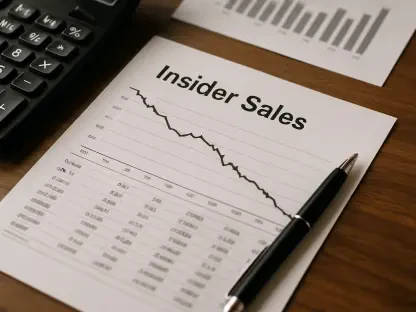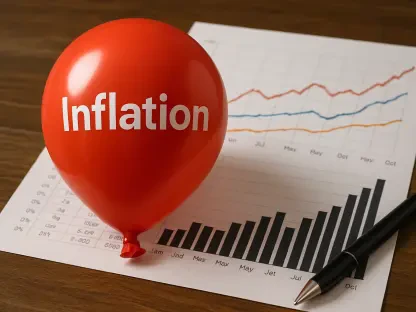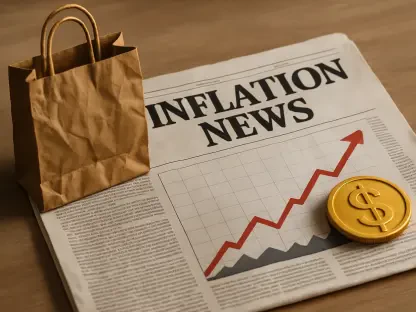Wall Street finds itself in a challenging position as it records a third consecutive day of losses on Thursday, September 25, marking a notable shift in market momentum that has caught the attention of investors. Major U.S. stock indexes, including the S&P 500, Dow Jones Industrial Average, and Nasdaq Composite, all posted declines, with the S&P 500 slipping 0.5% to 6,604.72, the Dow shedding 173.96 points or 0.4% to 45,947.32, and the Nasdaq falling 0.5% to 22,384.70. Despite these setbacks, the indexes hover near record highs set earlier in the week, underscoring a volatile environment where gains and losses are tightly intertwined. This downturn comes amid a backdrop of unexpectedly strong economic data, which, while a positive sign for the broader economy, is sparking unease among investors. The tension lies in how this economic resilience might influence Federal Reserve policies, potentially curbing anticipated interest rate cuts and reshaping market expectations in a way that could further test investor confidence.
Economic Data Fuels Investor Uncertainty
The recent string of losses on Wall Street is unfolding against a landscape of robust U.S. economic indicators that are creating a complex dynamic for investors. Reports showing a drop in unemployment benefit claims, accelerated economic growth during the spring, and solid orders for durable manufactured goods highlight a surprisingly strong economy. This strength is undoubtedly beneficial for workers and job seekers, signaling stability and opportunity in the labor market. However, for stock market participants, these positive developments carry a downside. There’s growing concern that such resilience might prompt the Federal Reserve to reconsider the pace of planned interest rate cuts. With the Fed having recently initiated its first cut of the year and signaling more through the end of the current cycle, a thriving economy could reduce the urgency for further reductions, raising fears of persistent inflation that might keep rates higher for longer and pressure stock valuations.
Adding to this uncertainty is the subtle shift in the bond market, where the 10-year Treasury yield edged up to 4.17% from 4.16%. This incremental rise reflects a recalibration among traders, who are now scaling back expectations for multiple rate cuts in the near term. Such adjustments are significant because much of the stock market’s upward trajectory since April has been fueled by the prospect of lower interest rates, which typically stimulate economic activity and bolster equity prices. When economic data suggests less need for monetary easing, it disrupts the narrative that has driven recent gains, contributing to the current pullback. Investors are left grappling with the paradox of a healthy economy potentially undermining the very conditions that have supported market growth, creating a cautious atmosphere where every new data point is scrutinized for clues about the Fed’s next steps and their implications for Wall Street.
Federal Reserve Policy Shapes Market Sentiment
The Federal Reserve’s monetary policy remains a pivotal factor influencing Wall Street’s current trajectory, with expectations around interest rate cuts playing a central role in market sentiment. For months, the anticipation of lower rates has been a key driver behind the stock market’s rally, as reduced borrowing costs often encourage corporate investment and consumer spending, lifting stock prices in the process. The Fed’s recent move to cut rates for the first time this year, coupled with indications of further reductions, had bolstered hopes for sustained economic growth. However, the latest economic strength is casting doubt on whether the Fed will follow through with as many cuts as previously expected. If the economy continues to perform well, the central bank might adopt a more conservative stance, prioritizing inflation control over aggressive stimulus, which could dampen the momentum that has propelled stocks to near-record levels.
This potential shift in policy outlook is raising alarms about market valuations, particularly after the rapid ascent in stock prices over recent months. Analysts, such as Jonathan Krinsky from BTIG, have pointed out the risks of investor complacency, noting that certain sectors appear overstretched in terms of valuation. With the S&P 500 and other indexes still close to their peaks despite the three-day decline, there’s a lingering concern that the market may be vulnerable to a more pronounced correction if the Fed signals a slower pace of rate cuts. Such a scenario could expose overvalued stocks to downward pressure, especially in areas where speculative growth has outpaced fundamentals. The interplay between Fed policy expectations and market pricing is thus a critical area of focus, as it will likely determine whether the current downturn is a temporary blip or the start of a broader reassessment of risk among investors.
Corporate Results Reflect Broader Volatility
Individual company performances during this period of market decline offer a window into the broader volatility affecting Wall Street. CarMax, for instance, experienced a sharp 20.1% drop in its stock price after reporting weaker-than-expected quarterly profits, compounded by declining vehicle sales and higher provisions for loan losses. Similarly, Jabil saw a 6.7% decline despite exceeding profit forecasts, largely due to a correction following an impressive 56.6% gain over the year, suggesting that even strong performers are not immune to market adjustments. Oracle also fell 5.6% after a recent surge tied to AI demand, while Starbucks dipped 0.5% amid a $1 billion restructuring plan involving store closures and layoffs. These varied outcomes highlight how operational challenges and market sentiment are intersecting to create a selective downturn, where not all companies are impacted equally by the broader economic and policy uncertainties.
On the other hand, some companies are bucking the trend with positive developments that underscore pockets of resilience. IBM, for example, gained 5.2% following a promising trial of quantum computing technology in collaboration with HSBC, demonstrating how innovation can still drive investor interest even in a challenging market environment. Meanwhile, KB Home reported stronger-than-expected profits, though its stock edged down 0.6% despite favorable conditions like easing mortgage rates that could spur homebuyer demand. These contrasting results illustrate the fragmented nature of the current market, where sector-specific dynamics and individual corporate strategies play a significant role in determining stock performance. As Wall Street navigates this three-day losing streak, the mixed signals from corporate earnings suggest that volatility will remain a defining feature, with investors carefully weighing risks against opportunities in a rapidly shifting landscape.
Navigating the Path to a Soft Landing
The central challenge facing Wall Street at this juncture is achieving a delicate balance in economic conditions that can sustain market stability. The ideal scenario, often referred to as a “soft landing,” involves the economy cooling just enough to justify continued Federal Reserve rate cuts without tipping into a recession. Such a balance is essential for maintaining investor confidence and preventing a deeper market slide that could erode recent gains. If economic growth moderates appropriately, it could provide the Fed with the flexibility to lower rates as planned, supporting stock prices while keeping inflation in check. However, if growth remains too robust, the risk of delayed or reduced rate cuts looms large, potentially exacerbating concerns about overvaluation and triggering further pullbacks in major indexes that are already showing signs of strain after three consecutive days of losses.
Globally, the uncertainty is not confined to the U.S., as European indexes have also dipped and Asian markets exhibit modest fluctuations, reflecting a shared apprehension about economic and policy directions. Yet, the primary focus remains on U.S.-specific indicators and Federal Reserve decisions, which are expected to heavily influence Wall Street’s near-term path. The hope among market participants is that upcoming economic data will provide clarity on whether the current downturn is a temporary adjustment or a precursor to more sustained challenges. As traders and analysts monitor these developments, the emphasis will be on discerning the Fed’s signals regarding monetary policy adjustments. Looking back, this period of market recalibration underscored the intricate dance between economic strength and financial markets, with each side poised to adapt to the other’s movements in a high-stakes environment where precision and foresight were paramount.









